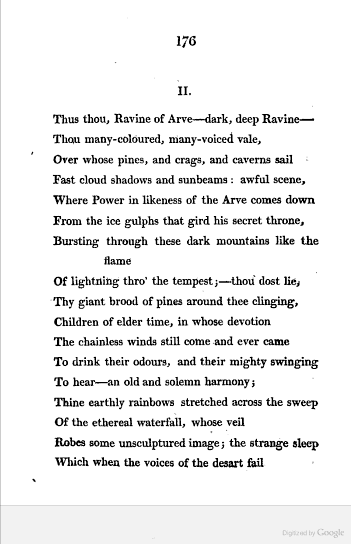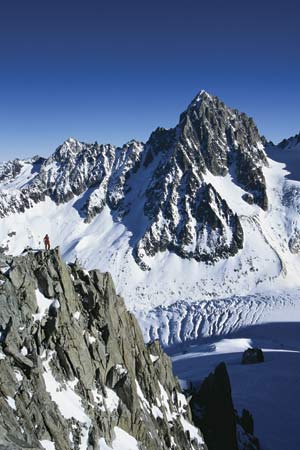By Percy Shelley
Table of Contents
Month Blanc Mountain, in Mont Blanc, France.
Overview
The Romantics like Percy Shelley saw a world of wonder around them. They envisioned a physical place that concealed yet represented a deep, rich reality beneath it, and believed that one could tap into this through the feelings and sensations elicited by the things they saw around them. The supernatural became a staple of the Romantic era, and poets of the time sought to understand and represent the ways in which people could commune with this essential world beneath the physical one. One such effort to accomplish this was Percy Shelley’s Mont Blanc, a poem that explores the physical reality of the largest mountain in Europe as well as the way those physical traits work to represent the hidden spiritual world. Shelley paints a vivid picture of the mountain itself, but very quickly dives in to an exploration of the ways in which the awe-inspiring landscape elicits an experience of transcendence that makes it possible to experience the world beyond the physical. While alternating between detailed description and evocative language, Shelley creates an image of Mont Blanc that reveals both the physical reality and the spiritual or supernatural reality of the mountain as well.
Analysis
Shelly immediately introduces a Romantic outlook of the world in the first stanza: “The everlasting universe of things/Flows through the mind, and rolls its rapid waves,/Now dark – now glittering – now reflecting gloom –/Now lending splendour, where from secret springs/The source of human thought its tribute brings/Of waters…” (1-6). Here, we are shown a mysterious universe that interacts with an observer’s mind in a way that unveils the physical world as a rolling ocean of shining possibilities. Even though this passage deals with the intangible, it does so through the language of natural entities that allows the reader to visualize something they may not have experienced based on things they have observed in the past. We are shown the image of flowing water and secret springs, and while these descriptions maintain their air of mystery, they also supply a conceptual framework for the reader in the same way that the speaker makes conclusions about the hidden world through his observations of the physical one later in the poem.
Shelley’s speaker goes further to wed the concept of the observable physical world to the less detectable universe postulated upon by the Romantics in the second stanza: “Thus thou, Ravine of Arve – dark, deep Ravine –/Thou many-coloured, many-voiced vale,/Over whose pines, and crags, and caravans sail/Fast cloud shadows and sunbeams: awful scene,/Where Power in likeness of the Arve comes down/From the ice gulphs that gird his secret throne,” (12-17). First, we are shown the physical characteristics of the ravine of the river Arve that comes down from the mountain. The speaker describes the “pines, and crags,” as well as the clouds in the sky and the sun, yet while these provide us with an image of what is being observed, these observations are revealed to be only a gateway into seeing something more. Shelly refers to this something as a “Power”, and the speaker explains that this entity is a manifestation from the world beyond in a physical form. The mountain exists in the physical world as a mountain, but upon observing this mountain and the things around it the speaker detects a great force that has formed itself into this image that may look like a mountain, but in reality is something entirely more profound. Shelly does not seek to explain or rationalize this view. His speaker simply observes and responds to those observations with his own emotions and feelings, and by doing so he gains the ability to see beyond the physical world to the world that lies beneath it.
Having explored how perception can allow a person to transcend into the spiritual world, the third stanza in turn begins to approach the question of how one is affected by such an experience. This speaker begins to muse on death and the unknown, voicing an uncertainty that has plagued men throughout human history, and concludes very little from this discussion before suddenly, from “Far, far above, piercing the infinite sky, / Mont Blanc appears, -still snowy and serene-” (60-61). The power and beauty of the mountain appears as something certain and “serene” after the speaker’s talk of death and dreams, and while we are given very concrete details about the physical world, those descriptions work as a bridge towards the spiritual world represented in the physical. We are shown the “unearthly forms” (62) of the smaller mountains around Mont Blanc as well as the “unfathomable deeps, / Blue as the overhanging heaven,” (64-65), and this language of transcendence from words like “unearthly” and “heaven” serve as another link between the physical and spiritual worlds. As the stanza concludes, we are shown that a faith in nature and the spiritual world it represents may prove strong enough to overcome the doubt and uncertainty of life: “The wilderness has a mysterious tongue / Which teaches awful doubt, or faith so mild, / So solemn, so serene, that man may be, / But for such faith, with nature reconciled;” (74-79). The benefits of this trust are made immediately clear when the speaker explains that “Thou hast a voice, great Mountain, to repeal / Large codes of fraud and woe;” (80-81). Nature is shown to be a positive guiding force based on its intimate connection with the spiritual world beyond, and by putting faith in this truth, one is able to navigate the uncertainties of life.
In the forth stanza, the concept of transcendence is further developed as the speaker tells us “All things that move and breathe with toil and sound / Are born and die; revolve, subside, and swell. / Power dwells apart in its tranquility,” (94-96). Even if we do not put our faith in nature, the “Power” which the speaker has already associated with the mountain in the second stanza remains “in its tranquility,” and will endure well beyond our mortal life spans. Therefore, we are faced with the choice of embracing the natural order and finding transcendence in nature and the world around us, or living in doubt and consequently arriving at the same inevitable end of life anyway. A connection with nature and the spiritual world seems to offer up a far more harmonious alternative to doubt and uncertainty when one considers that either path leads to the same end.
While the poem begins with a depiction of the spiritual world that makes use of physical descriptions to allow the reader to conceptualize the spiritual, the last stanza seems to create a variation on that approach. The description appears to be rooted more in the physical world at first, yet we are able to see clearly how those physical traits correlate into the spiritual world. While we are shown the mountain one last time, we are also told that “The secret Strength of things / Which governs thought, and to the infinite dome / Of Heaven is as a law, inhabits [the mountain]”, (139-141) reminding us once more of the connection between the physical world and the spiritual one beyond. The poem concludes with a potent question: “And what were thou, and earth, and stars, and sea, / If to the human mind’s imaginings / Silence and solitude were vacancy?” (142-144). While the question has not be explicitly answered by other parts of the poem, we have already been shown that whether or not humans connect with the spiritual world it will still persist in its full strength long after we have died. Since regardless of what we think the world will continue to exist around us, it must be humans who would be affected if we envisioned “Silence and solitude [as] vacancy”. Here, it seems as if the speaker is highlighting the fact that it is not enough to simply see the world to connect with the spiritual one beyond it. Some faculty of the “human mind’s imaginings” is required to make this connection, to see beyond what we might be fooled into believing was “vacancy”, and that is what allows us to see beneath the surface of reality in order to perceive the transcendent spiritual world concealed within the physical.
Mont Blanc as Romantic Poetry
Characteristics of Romantic Poetry-
- More personal than before; The Romantics brought a new sense of importance focused on the poet himself.
- Shelley appears to find a personal connection with the mountain, and it causes his mind to wander and question things such as life and death and the “everlasting universe of things”.
- Imagination
- His ability and desire to treat the mountain as a person (personification) because it is too big to take in otherwise shows his creativity.
- Emotions
- The mountain represents an extremely emotional and powerful force.
- Shelley explores the idea of life and death after realizing that the mountain with remain forever even after humans have died.
- “The works and ways of man, their death and birth,
And that of him, and all that his may be;
All things that move and breathe with toil and sound
Are born and die; revolve, subside, and swell.
Power dwells apart in its tranquility” (Lines 92-97)
- “The works and ways of man, their death and birth,
- Nature
- Literally speaking, “Mont Blanc” is obviously about mountain, which can be inferred from the title. The symbol of the largest mountain in the alps is a symbol of the power of nature.
- The second stanza is composed of tons of observations that Shelley makes as he takes in the mountain and nature surrounding it.
- Interest in the Supernatural World
- Shelley encounters the supernatural world when a ghost appears in stanza two.
- “In the still cave of the witch Poesy,
Seeking among the shadows that pass by
Ghosts of all things that are, some shade of thee,
Some phantom, some faint image; till the breast
From which they fled recalls them, thou art there!” (Lines 44-48)
- “In the still cave of the witch Poesy,
- Shelley encounters the supernatural world when a ghost appears in stanza two.
Read by Ben Karlin


The first two pages of the poem as an exert from Percy and Mary Shelley’s “History of a Six Weeks’ Tour through a Part of France, Switzerland, Germany and Holland”. The rest of the poem can be found on Google Books on page 175.
Sources
“Mont Blanc”. Encyclopædia Britannica. Encyclopædia Britannica Online.
Encyclopædia Britannica Inc., 2012. Web. 17 May. 2012
<http://www.britannica.com/EBchecked/topic/68844/Mont-Blanc>.
Shelley, Percy B. History of a Six Weeks’ Tour Through a Part of France, Switzerland, Germany. London: T. Hookham, 1817. Google Books. Web. 17 May 2012. <http://books.google.com/books?id=u1YJAAAAQAAJ>.

